CRM systems are everywhere, but adoption remains stubbornly low — and that’s a bigger problem than most sales leaders admit. At its core, this issue pits accountability against individual autonomy. Do reps serve the CRM, or does the CRM serve the rep?
The problem gets worse when we judge sales reps by the systems they didn’t choose. The CRM becomes a surveillance tool rather than a platform to support your reps — while managers are flying blind and sales forecasts are skewed by incomplete data.
In this article, we’ll review:
- Why sellers are struggling with existing CRM systems
- How the right sales enablement platform removes these barriers
- How Bigtincan accelerates CRM adoption amongst sellers
Why are sellers struggling to work with existing CRM systems
The numbers tell a sobering story. A Forrester report found that while CRM adoption rates are high (above 60%), many companies are not satisfied with their CRM initiatives. There are several reasons why this might be happening:
CRM data entry takes time away from selling
Your reps are spending more time feeding the CRM than actually selling. The average sales professional dedicates 2-3 hours daily to administrative tasks, with CRM data entry eating up a significant chunk of that time.
Think about what happens after every customer interaction. Reps need to log call notes, update opportunity stages, record next steps, and capture contact information. Multiply this across dozens of prospects and deals, and you've got a recipe for frustrated sellers who'd rather be building relationships and closing deals.
The mobile experience makes things worse. Trying to update detailed CRM records on a smartphone while walking out of a client meeting? It's clunky at best and impossible at worst. So important details get forgotten, deals lose momentum, and managers lose visibility into what's happening in the field.
Disconnected tools disrupt existing workflows
Modern sales teams juggle an average of 10+ different tools daily. Here's a list of tools sales teams use every day:
- CRM
- Calendar apps
- Content management systems
- Video conferencing platforms
- Proposal software
And the list goes on. Each tool serves a purpose, but none of them talk to each other effectively.
Picture this: A rep is in Salesforce reviewing an opportunity, needs to grab a case study from the company's content portal, draft an email in Outlook, schedule a follow-up meeting in their calendar app, and then remember to log all of these activities back in the CRM. That's four different systems for one simple workflow.
The constant context-switching kills productivity and creates gaps where important information falls through the cracks. When systems don't integrate seamlessly, reps develop workarounds that often bypass the CRM entirely.
Finding the right content at the right time is nearly impossible
Content sprawl is real. Marketing creates hundreds of assets — case studies, product sheets, presentations, videos — that get scattered across shared drives, marketing platforms, and individual laptops.
When a seller needs the perfect piece of content for a specific buyer situation, they're often left searching through folders or, worse, recreating something from scratch.
The real challenge is finding the right content. What works for a mid-market manufacturing prospect in the discovery phase is very different from what works for an enterprise healthcare buyer ready to evaluate vendors. However, most content systems don't offer intelligent recommendations based on deal context.
As a result, reps either spend valuable time hunting for materials or default to generic, one-size-fits-all content that doesn't move deals forward. In the meantime, marketing's best assets gather dust in your drives because they're too hard to find and deploy.
Limited visibility into prospect engagement hurts deal progression
After sending a proposal or sharing a presentation, most reps enter a black hole of uncertainty. Did the prospect open the email? How long did they spend reviewing the materials? Which sections generated the most interest? Who else in their organization saw the content?
Traditional CRM systems capture the "what" (email sent, meeting scheduled) but miss the "how" (engagement depth, content effectiveness). This lack of insight makes it nearly impossible to:
- Time follow-up communications
- Tailor conversations to needs
- Identify when deals are stalling
- Coach reps on which content and messaging work
Without this visibility, reps are essentially flying blind through complex sales cycles, making assumptions about buyer interest that may be completely wrong.
Inconsistent processes lead to missed opportunities
When CRM adoption is low, sales processes become inconsistent across the team. Some reps are diligent about logging activities, others update when they get time, and a few barely touch the system at all. This creates several problems:
- Forecasting becomes guesswork: Managers can't trust pipeline data when half the team isn't consistently updating opportunity data. Revenue predictions become exercises in hope rather than data-driven analysis.
- Coaching opportunities get missed: Without standardized data capture, it's impossible to identify patterns in what works and what doesn't. New reps struggle to learn from top performers because their successful behaviors aren't systematically documented.
- Handoffs fall apart: When accounts transition between reps or involve multiple team members, inconsistent CRM hygiene means critical context gets lost. Prospects often end up repeating their stories, viewing irrelevant content, or encountering gaps in service.
The result is a vicious cycle. Poor adoption leads to unreliable data, which makes the CRM less effective and reduces adoption rates.
How sales enablement software helps sellers do better work faster
The most effective sales enablement software meets sales reps where they already work instead of forcing them into a separate workflow. That’s why Bigtincan offers the following capabilities to drive CRM adoption:
1. Work directly within your existing CRM and email tools
Instead of asking reps to learn another system, Bigtincan brings content and intelligence directly into Salesforce and Outlook — the applications where sellers already spend their time.
Inside Salesforce, Bigtincan shows up as if it's always been there. Reps can search for content, get AI recommendations, and share materials without opening a single new tab. When you’re speaking with prospects, or you send them something, all you have to do is update the Salesforce record within Bigtincan.

The Outlook integration works similarly. As your reps write emails, they can grab the perfect piece of content, customize it on the spot, and everything gets logged back to Salesforce automatically. The platform even reads the email conversation and suggests materials that make sense for what they're discussing. The same goes for organizations using Gmail.
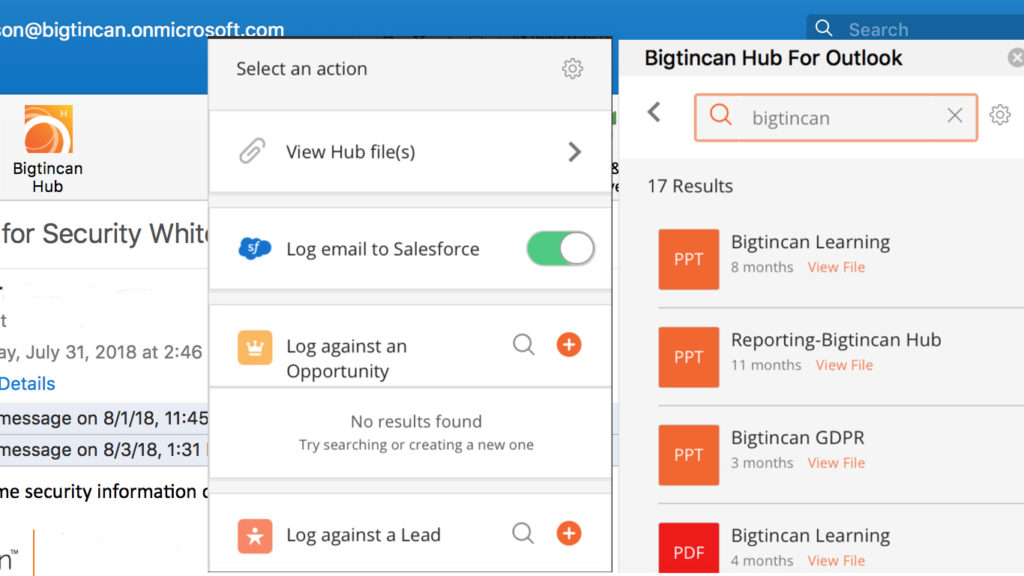
Bigtincan for Outlook
This approach eliminates the context-switching that kills productivity. Everything happens right where reps are already working, so adoption feels natural instead of forced.
2. Reduce distracting sidework by automating note logging in the CRM
Getting sales teams to consistently log their meetings and notes in the CRM can feel like herding cats — and for good reason. To a seller, it feels more like distracting sidework than a valuable use of their time (even if it is for the sake of the data).
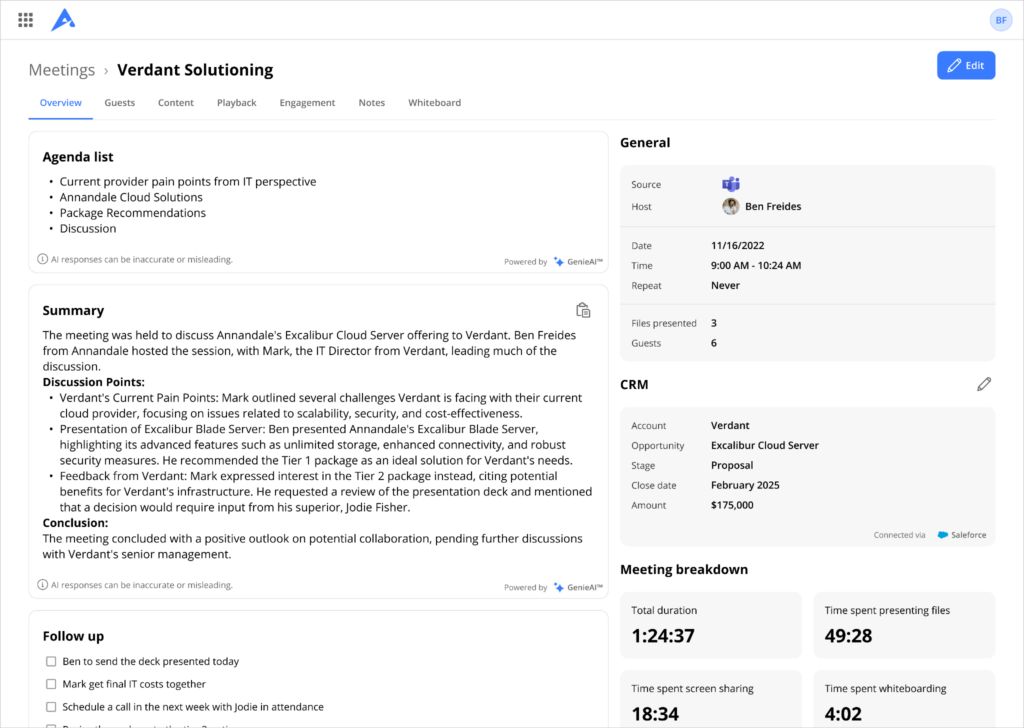
Bigtincan Meetings summary with details autologged in the CRM by MeetingsAI
That’s where Bigtincan Meetings and MeetingsAI come in. Instead of forcing reps to spend precious selling time on manual data entry, these tools automatically capture and log all the important details — think AI-generated summaries, action items, and even insights into how the conversation went — right into your CRM.
No more guessing what happened on a call or chasing down updates. Managers get instant visibility into team activities, so they can jump in to coach or save a deal when it matters most. Plus, with content and engagement analytics tied directly to your CRM, marketing and enablement teams finally get the insights they need to keep messaging sharp.
The result? Your CRM becomes a living, breathing hub of sales intelligence — without the usual hassle.
3. Get intelligent content recommendations based on your specific deals
Most content libraries are just fancy filing cabinets. Bigtincan's GenieAI is more like having a really smart assistant who knows exactly what content works for which situations.
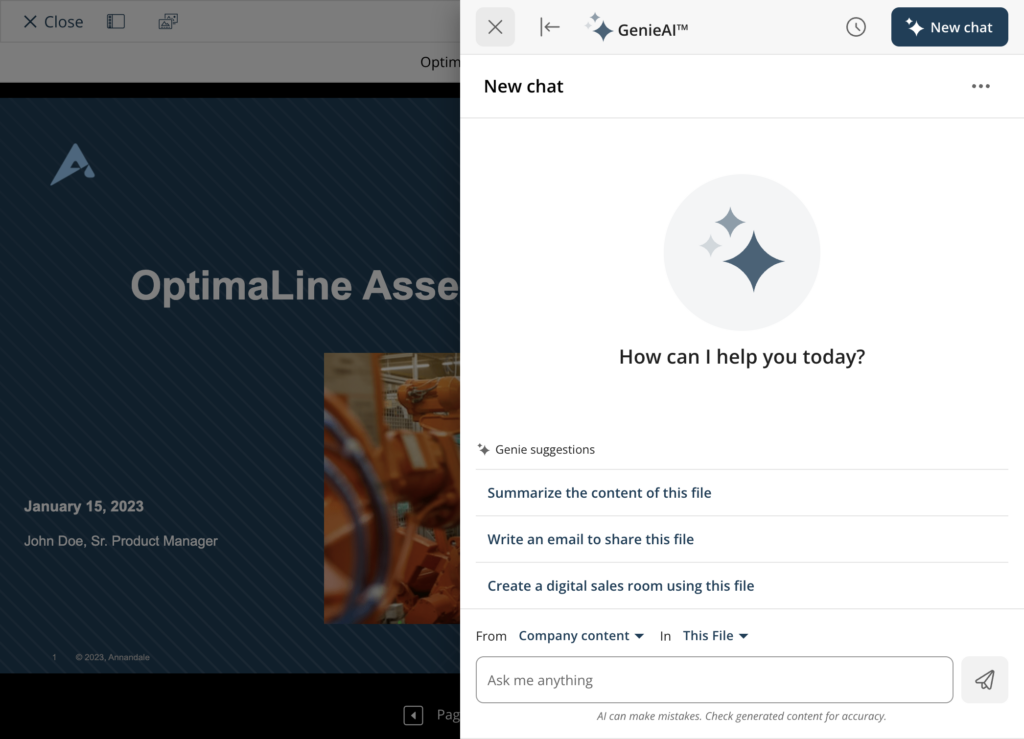
The platform looks at your deal details — stage, industry, company size, what products they're interested in — and serves up materials that match what you're trying to accomplish. So, if you're working on an enterprise healthcare deal in the evaluation phase, you'll see completely different suggestions than someone chasing a small manufacturing prospect in discovery.
GenieAI learns from your top performers. It studies which content combinations actually move deals forward and shares those insights across your entire team. New reps instantly benefit from your best sellers' experience, while seasoned pros discover materials they didn't know existed.
The recommendations pop up contextually, too. If you're viewing an opportunity, relevant content appears automatically. If you're writing an email, GenieAI suggests materials based on who you're talking to and what you've discussed before. It's like having institutional knowledge at your fingertips.
4. Find answers instantly with SearchAI across all your content
Traditional search is basically "guess the right keyword and hope for the best." SearchAI lets you ask actual questions, just as if you're talking to a colleague who knows everything about your company.
Instead of searching for "competitive analysis," you can ask, "How do we stack up against [competitor] on data security?" SearchAI sifts through all your content — presentations, training materials, product documents, and case studies — and provides you with specific, relevant answers.
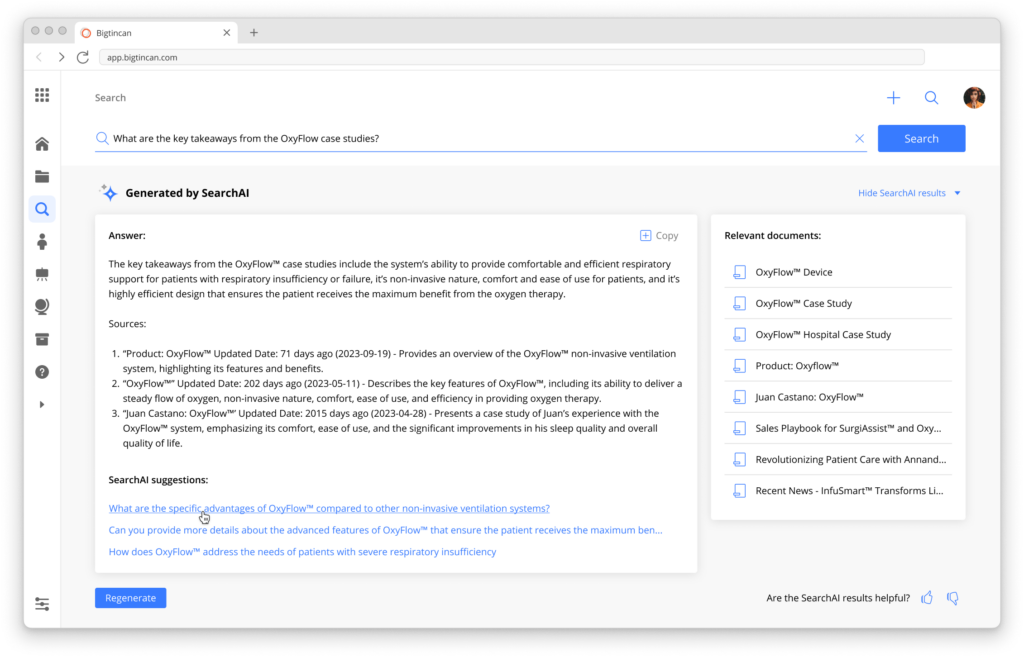
The platform also becomes smarter based on context. Search for "pricing" while working on an enterprise deal, and you'll get enterprise pricing info. If you run the same search on a small business opportunity, you'll see SMB pricing instead. It considers your role, current deals, and what you have access to.
And when you can't find exactly what you need, SearchAI suggests similar content or flags gaps where new materials might help. Additionally, you can even expand that search to surf external web sources to get more source coverage.
5. Engage buyers with interactive Digital Sales Rooms
Email attachments are so 2010. Digital Sales Rooms (DSRs) create collaborative spaces where buyers can explore content, ask questions, and dig deeper into their own timelines.
Each DSR becomes a deal hub with all your content, communications, and resources in one organized place. Buyers can access presentations, videos, case studies, and technical documents without having to hunt through email chains for "that document from three weeks ago."
The SearchAI integration makes this even better. Prospects can ask specific questions about your shared content and get immediate answers. "What's the implementation timeline for enterprise clients?" or "How does pricing work for multi-year deals?" become searchable queries instead of reasons to schedule another call.
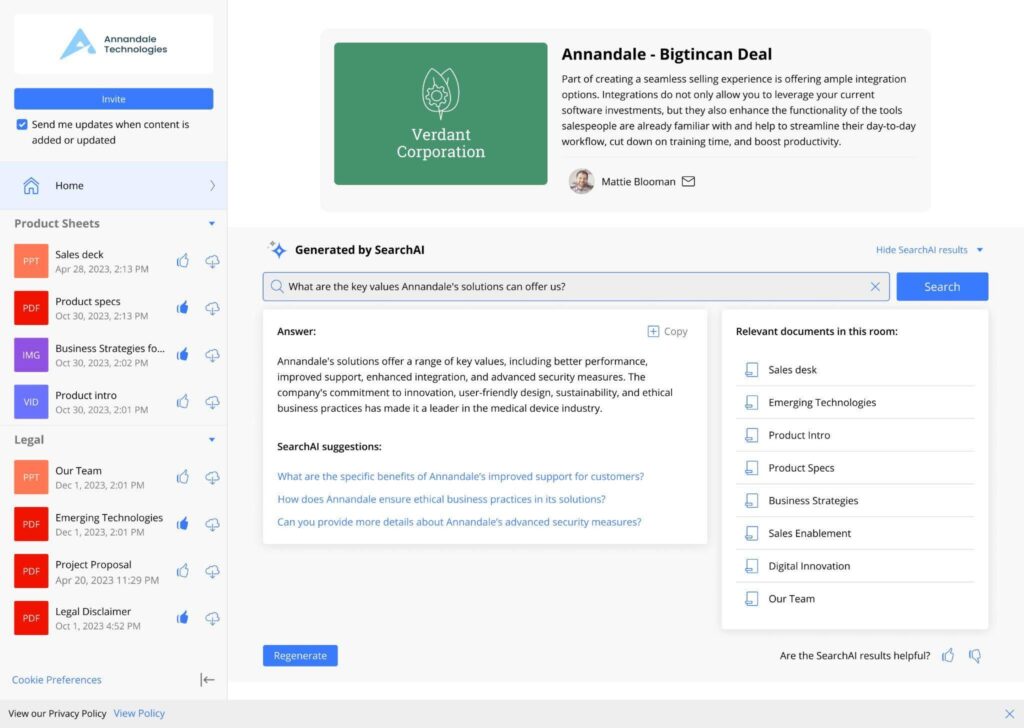
SearchAI in a DSR
For reps, DSRs provide incredible visibility into buyer behavior.
You can see which materials generate the most interest, how long prospects spend on different sections, and who else in their organization is poking around. This intel helps you tailor follow-up conversations and spot when deals are heating up or cooling down.
6. Understand what content moves deals forward
Some sales teams create content, cross their fingers, and hope it works. Bigtincan gives you actual data about what resonates with buyers and what doesn't.
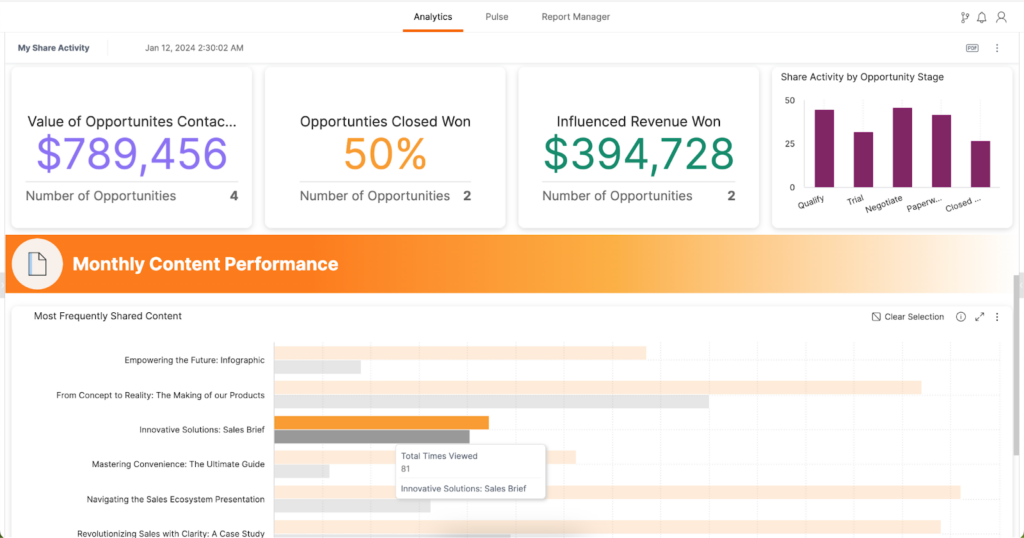
The platform tracks engagement metrics across all materials:
- Open rates
- Average session duration
- Download frequency
- Sharing patterns
But more importantly, it connects content usage to deal outcomes, encouraging adoption of both content in general (always a good thing) and usage of content within the CRM.
It answers questions like: Which case studies show up in closed-won deals? What presentations consistently move opportunities to the next stage? Which materials are gathering digital dust? When you have the information in place to answer these questions, you can get a clear picture of how content influences revenue.
Making CRM work for reps, not against them
Let's circle back to that question we started with: Do reps serve the CRM, or does the CRM serve the rep?
For way too many sales teams, the answer has been obvious — and frustrating. Reps have been stuck serving systems that make their jobs harder, not easier. As a result, you deal with low adoption rates, incomplete data, and the whole Big Brother vibe that undermines motivation and performance.
Bigtincan flips the script completely. Instead of forcing reps to change how they work to feed another system, the platform adapts to real workflows. It adds intelligence to tools people already use, cuts out the busywork, and delivers insights that help close deals.
You can integrate it with your favorite CRM tools and use Bigtincan there — or sync and update all your data within Bigtincan, which in turn updates everything in your CRM.
You don't have to choose between accountability and letting reps do their thing. The right sales enablement platform gives you both: reps get the freedom to work efficiently while managers get the visibility they need to support their teams.
If you want to see how Bigtincan helps with increasing CRM adoption rates, get in touch with our team today.
